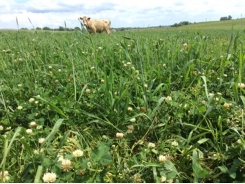How to Plant Asparagus

Done right, planting a bed of asparagus is a once-in-a-generation affair. Other than artichokes, capers and rhubarb, asparagus is the only perennial vegetable regularly featured in North American cuisine — it will send up those slender, succulent stalks each spring for decades if it is given a happy home. Early spring, before its roots awaken from dormancy, is the traditional planting time.
But be prepared, this is no ordinary vegetable crop. Asparagus has a colorful history and seductive personality. And it is probably the most demanding vegetable there is to get started.
STEP ONE — PROCURE THE CROWNS
It’s possible to grow asparagus by seed, but most farmers and gardeners leave this part to a professional nursery because the seed is so finicky to germinate. Instead, buying asparagus ‘crowns’—a technical term for the dormant roots—is recommended. They look like a strange sea creature with roots for tentacles and a head in the middle where the spears sprout.
The dormant crowns are available at local garden centers for a brief window in early spring, after the ground thaws, but before the crowns start sprouting. If you miss that window, it’s still possible to order them online from nurseries farther north. Some growers keep asparagus crowns in their walk-in cooler to prolong dormancy so southern gardeners running late on the garden season have something to plant.
Heirloom varieties like ‘Martha Washington’ are still quite popular, though they produce male and female plants. Female asparagus plants produce pretty red berries in fall, but they make far fewer spears. To get a larger harvest, many growers opt for all-male hybrid varieties like ‘Jersey Giant’ or ‘UC 157’, which are highly productive and usually more disease-resistant than the heirloom types. ‘Purple Passion’ is one of the many varieties that produce purple spears. Growing white asparagus is a matter of layering soil over the spears so they don’t produce chlorophyll; you can do this with any variety.
Ten crowns will fit in a 4-by-8-foot bed and are generally enough to supply a family of four. Try to time your purchase so the asparagus crowns can go in the ground without delay. If you have to store the crowns for more than a day or two, place them in a bucket of moist sand in a basement or other cool environment until you are ready to plant.
STEP TWO — PREPARE THE SOIL
Asparagus likes rich, well-drained, non-acidic soil. For best results, copious quantities of soil amendments should be incorporated into the planting bed to provide long-term fertility
- Remove any existing vegetation from the planting area, including roots.
- Loosen the soil to a depth of 6 or 8 inches over the entire planting area with a tiller or digging fork.
- Spread 2 to 3 inches of compost over the planting area and mix it into the soil.
- If your soil is acidic, add sufficient lime to bring the pH up to 7 and mix it into the planting area*
- Dig a trench 12 inches wide by 12 inches deep where the crowns are to be planted. Rows of asparagus should be at least 2 feet apart, allowing two rows to fit in a 4-foot wide bed.
- For every 8 feet of row space, you will need about a wheelbarrow filled two-thirds of the way with equal parts of the excavated soil and compost.
- Add three cups of all-purpose organic vegetable fertilizer into the soil/compost mixture. To give the asparagus an extra boost, add a cup or two of greensand (an all-natural fertilizer that is high in potassium) to the excavated soil in the wheelbarrow and thoroughly mix.
Your local cooperative extension service office can test your soil pH and tell you exactly how much lime to add to bring it up to 7.
STEP THREE — PLANT
- Spread the contents of the wheelbarrow evenly along the length of the trench.
- Form conical mounds about 6 inches tall every 18 inches along the base of the trench with the soil/amendment mixture.
- Place one crown on top of each mound with the roots splayed out in every direction.
- Cover the crowns with two inches of soil (filling in the spaces between each mound, as well).
- Water deeply at this time.
STEP FOUR — CONTINUE FILLING AND WATERING
- As the asparagus grows, continue to fill in the trenches with the remaining excavated soil.
- Keep the asparagus bed moist, but not soggy throughout the first growing season.
- Spread a layer of mulch over the bed to help conserve moisture and reduce weed germination.
It’s important to wait at least one year after planting asparagus before making the first harvest so the plants can put as much energy as possible into developing a root system. In the second year, it’s OK to harvest any spears larger than a pencil for a week or so. In the third year, increase the harvest period to two weeks and in the fourth and subsequent years you can harvest all the spears that emerge over a six-week period.
Unharvested spears will unfurl into a lacy canopy of foliage about 3 or 4 feet tall by early summer. Allowing the stalks to grow each year is necessary for maintaining a strong root system making it possible for the asparagus to come back year after year with bigger and bigger spears.
Có thể bạn quan tâm
Phần mềm

Phối trộn thức ăn chăn nuôi

Pha dung dịch thủy canh

Định mức cho tôm ăn

Phối trộn phân bón NPK

Xác định tỷ lệ tôm sống

Chuyển đổi đơn vị phân bón

Xác định công suất sục khí

Chuyển đổi đơn vị tôm

Tính diện tích nhà kính

Tính thể tích ao hồ



 How to Build a Straw Bale Garden
How to Build a Straw Bale Garden  Researcher finds way to boost protein yield per…
Researcher finds way to boost protein yield per…